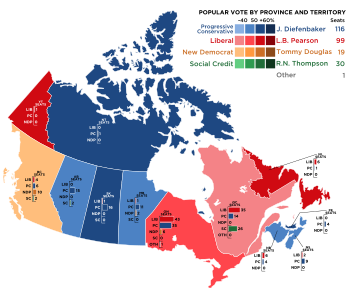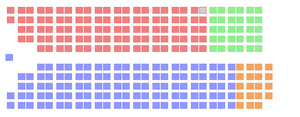
Back Kanadische Unterhauswahl 1962 German Elecciones federales de Canadá de 1962 Spanish Élections fédérales canadiennes de 1962 French Elezioni federali in Canada del 1962 Italian Канадские федеральные выборы (1962) Russian 1962年加拿大联邦大选 Chinese
| |||||||||||||||||||||||||||||||||||||||||||||||||||||||||||||||||||||||||||||
265 seats in the House of Commons 133 seats needed for a majority | |||||||||||||||||||||||||||||||||||||||||||||||||||||||||||||||||||||||||||||
|---|---|---|---|---|---|---|---|---|---|---|---|---|---|---|---|---|---|---|---|---|---|---|---|---|---|---|---|---|---|---|---|---|---|---|---|---|---|---|---|---|---|---|---|---|---|---|---|---|---|---|---|---|---|---|---|---|---|---|---|---|---|---|---|---|---|---|---|---|---|---|---|---|---|---|---|---|---|
| Turnout | 79.0%[1] ( | ||||||||||||||||||||||||||||||||||||||||||||||||||||||||||||||||||||||||||||
| |||||||||||||||||||||||||||||||||||||||||||||||||||||||||||||||||||||||||||||
 | |||||||||||||||||||||||||||||||||||||||||||||||||||||||||||||||||||||||||||||
 The Canadian parliament after the 1962 election | |||||||||||||||||||||||||||||||||||||||||||||||||||||||||||||||||||||||||||||
| |||||||||||||||||||||||||||||||||||||||||||||||||||||||||||||||||||||||||||||
The 1962 Canadian federal election was held on June 18, 1962, to elect members of the House of Commons of Canada of the 25th Parliament of Canada. The governing Progressive Conservative (PC) Party won a plurality of seats in this election, and its majority government was reduced to a minority government.
When the election was called, PC Prime Minister John Diefenbaker had governed for four years with the largest majority until then in the House of Commons in Canadian history.
This election reduced the PCs to a tenuous minority government as a result of economic difficulties such as high unemployment and a slumping Canadian dollar, as well as unpopular decisions such as the cancellation of the Avro Arrow. Despite the Diefenbaker government's difficulties, the Liberal Party, led by Lester B. Pearson, was unable to make up enough ground in the election to defeat the government. For Social Credit, routed from the Commons just four years earlier, this election proved to be their most successful ever since they would never better the 30 seats won; for example, they lost seats in 1963 despite gaining a slightly better share of the vote.
This was the first election in which all adult Canada's Indigenous Peoples had the right to vote after the passage on March 31, 1960 of a repeal of certain sections of the Canada Elections Act.[2]
For the first time ever, the entire land mass of Canada was covered by federal electoral districts (the former Mackenzie River riding was expanded to cover the entire Northwest Territories).
This was also the first general election contested by the New Democratic Party.
- ^ Pomfret, R. "Voter Turnout at Federal Elections and Referendums". Elections Canada. Elections Canada. Retrieved February 23, 2014.
- ^ "Canadian Encyclopedia". March 31, 2016. Retrieved April 29, 2018.
Cite error: There are <ref group=lower-alpha> tags or {{efn}} templates on this page, but the references will not show without a {{reflist|group=lower-alpha}} template or {{notelist}} template (see the help page).
© MMXXIII Rich X Search. We shall prevail. All rights reserved. Rich X Search


